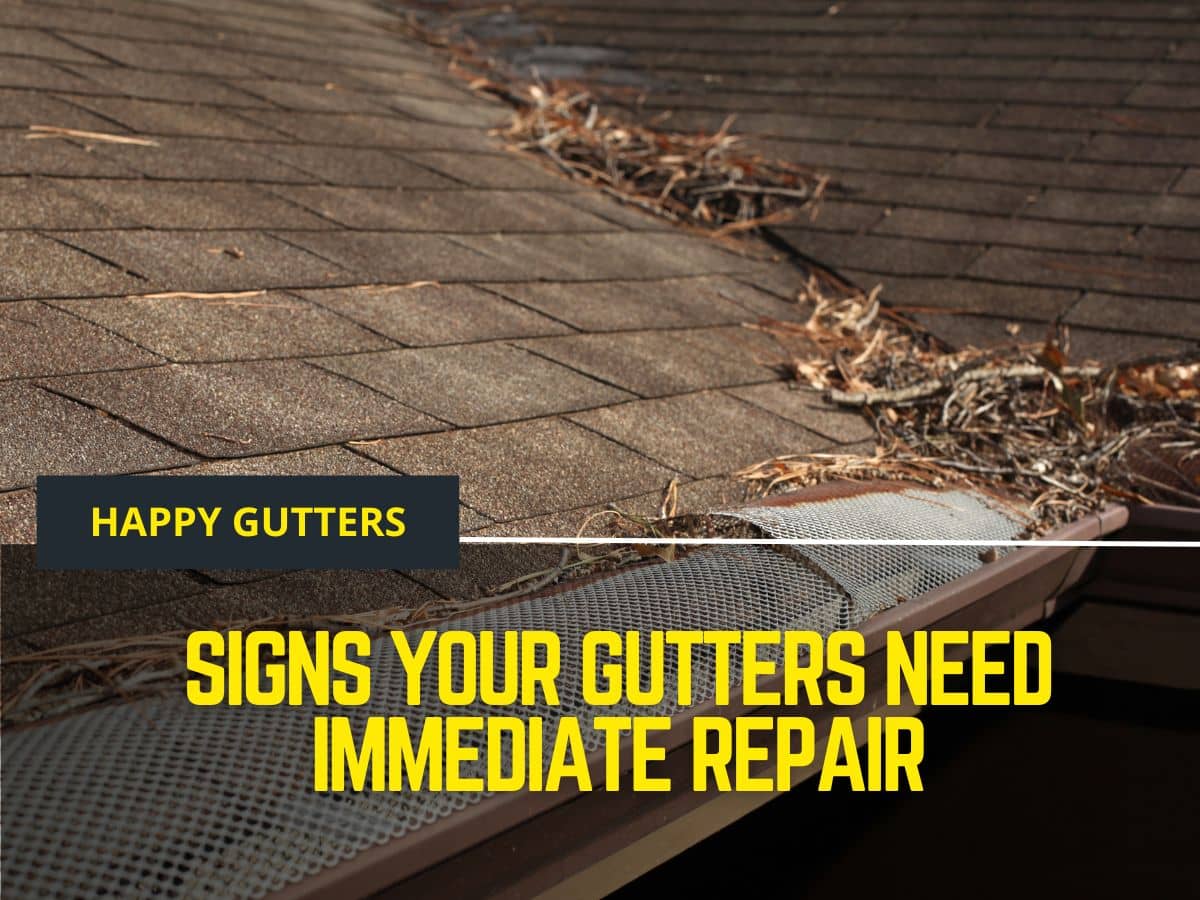
Introduction: Gutters are an essential component of any home’s external structure, responsible for directing rainwater away from the foundation and preventing water damage. However, over time, gutters can become damaged, clogged, or inefficient, compromising their ability to protect your home. In this blog post, we will discuss the signs that indicate your gutters need immediate repair, emphasizing the importance of taking prompt action to avoid costly water damage.
I. The Gutters’ Exterior:
The first step in identifying gutter problems is to inspect the gutters’ external appearance. Here are some signs to look out for:
- Sagging Gutters: Take note if your gutters are visibly sagging or pulling away from the house. This indicates that the gutter system has become compromised, possibly due to excessive debris accumulation or inadequate support brackets. Sagging gutters can result in poor water flow and potential water pooling near the foundation, leading to costly foundation damage.
- Visible Cracks, Holes, or Rust: Check for any damage such as cracks, holes, or rust on the gutter surface. These issues can obstruct the proper flow of water and cause it to leak onto your home’s exterior walls or foundation. Ignoring these signs can lead to severe water damage and compromise the structural integrity of your property.
- Gutter Joints and Brackets: Inspect the joints and brackets that hold the gutters together. Loose or damaged components can cause gutters to become unstable and prone to separation. If not addressed promptly, this can result in water overflowing and seeping into your home’s foundation.
Regularly inspecting your gutters’ exterior can help you detect these potential problems early on and prevent further damage.
II. Water Overflow and Diversion:
Inspecting the flow of water within your gutters and its proper diversion away from your home is crucial for keeping your property safe from water-related damages. Watch out for the following signs:
- Water Pooling Near the Foundation: If you notice water pooling near your home’s foundation, it indicates that your gutters are not effectively diverting water away from the property. This can lead to expensive foundation repairs, as excessive water can penetrate the foundation, causing cracks and compromising its stability. Immediate repair and maintenance are necessary to avoid severe damage.
- Leaky or Separated Downspouts: Ensure that your downspouts are securely attached and properly functioning. Leaks or separations can result in water being deposited too close to your home, potentially causing foundation erosion or basement flooding. Prompt gutter repair and downspout reattachment are essential to prevent further damage and ensure proper water diversion.
- Clogged or Disconnected Downspouts: Keep an eye out for downspouts that are clogged or disconnected from the gutters. When downspouts are blocked, water overflows, leading to potential damage to your home’s exterior walls, foundation, or landscaping. Make sure to clear any clogs and reattach disconnected downspouts to maintain an effective drainage system.
Regularly checking for water overflow and diversion issues can help you identify gutter problems in a timely manner and protect your home from water damage.
III. Gutters’ Interior:
While examining your gutters’ exterior is crucial, do not forget to inspect their interior as well. The following signs should not be ignored:
- Rotting or Peeling Paint on Fascia or Soffits: If you notice the paint on your fascia or soffits is peeling or rotting, it may be an indication of prolonged moisture exposure. Faulty gutters can cause water to overflow onto these surfaces, leading to damage that should be resolved immediately.
- Accumulation of Shingle Granules in Gutters: Check for the buildup of shingle granules in your gutters. These granules are commonly present in asphalt shingles and indicate roof deterioration. When gutters are not functioning properly, excess granules can accumulate, potentially causing blockages and impeding water flow.
- Presence of Mold, Mildew, or Pests: Inspect your gutters for any signs of mold, mildew, or pest infestations. Excessive moisture caused by clogged or leaking gutters can create a favorable environment for mold and mildew growth, which can be harmful to your health. In addition, gutter debris can attract pests, leading to potential damage. Cleaning and repairing your gutters promptly can prevent these issues.
Regularly examining the interior of your gutters will help you identify problems that might go unnoticed, allowing you to take immediate action and avoid further damage to your home.
IV. Gutters Handling Heavy Rainfall:
Your gutters must be capable of handling heavy rainfall to prevent water damage during storms. Consider the following signs:
- Gutter Overflow during Rainfall: Monitor your gutters during heavy rain to ensure they are not overflowing. If water is spilling over the sides, it indicates an issue with either the gutter sizing or excessive debris blocking the flow. Prompt gutter cleaning and repair are necessary to avoid water entering your home or causing damage to the surrounding landscape.
- Consequences of Water Damage during Heavy Rain: Failure to address gutter problems can lead to significant water damage. This includes potential basement flooding, compromised structural integrity, and damage to the foundation and landscaping. Ensuring your gutters are well-maintained and designed to handle heavy rainfall is crucial for protecting your home.
Before the rainy season, schedule maintenance and repairs to ensure your gutters are in optimal condition and ready to handle heavy rain effectively.
V. Winter-Specific Issues:
Winter weather brings its own set of challenges for gutters. Consider the following precautions:
- Ice Dams: Ice dams can form on gutters and roofs during freezing temperatures. These ice formations prevent proper water flow and can cause water to back up into your home, resulting in roof leaks and water damage. Before winter arrives, ensure your gutters are clear of any debris and consider installing gutter guards to prevent ice buildup and clogging.
Taking proactive measures in the fall by inspecting and repairing your gutters will protect your home during the winter months.
Conclusion: Regularly inspecting and maintaining your gutters is essential for avoiding costly water damage to your home. By paying attention to the signs discussed in this blog post, such as sagging gutters, water overflow, interior damage, and issues related to heavy rainfall and winter weather, you can identify when gutter repairs are needed. Remember to seek the assistance of professional gutter contractors or a local gutter company for dependable gutter cleaning and repair services. Taking immediate action will safeguard your home’s infrastructure and foundation from potential devastation caused by leaking gutters.


